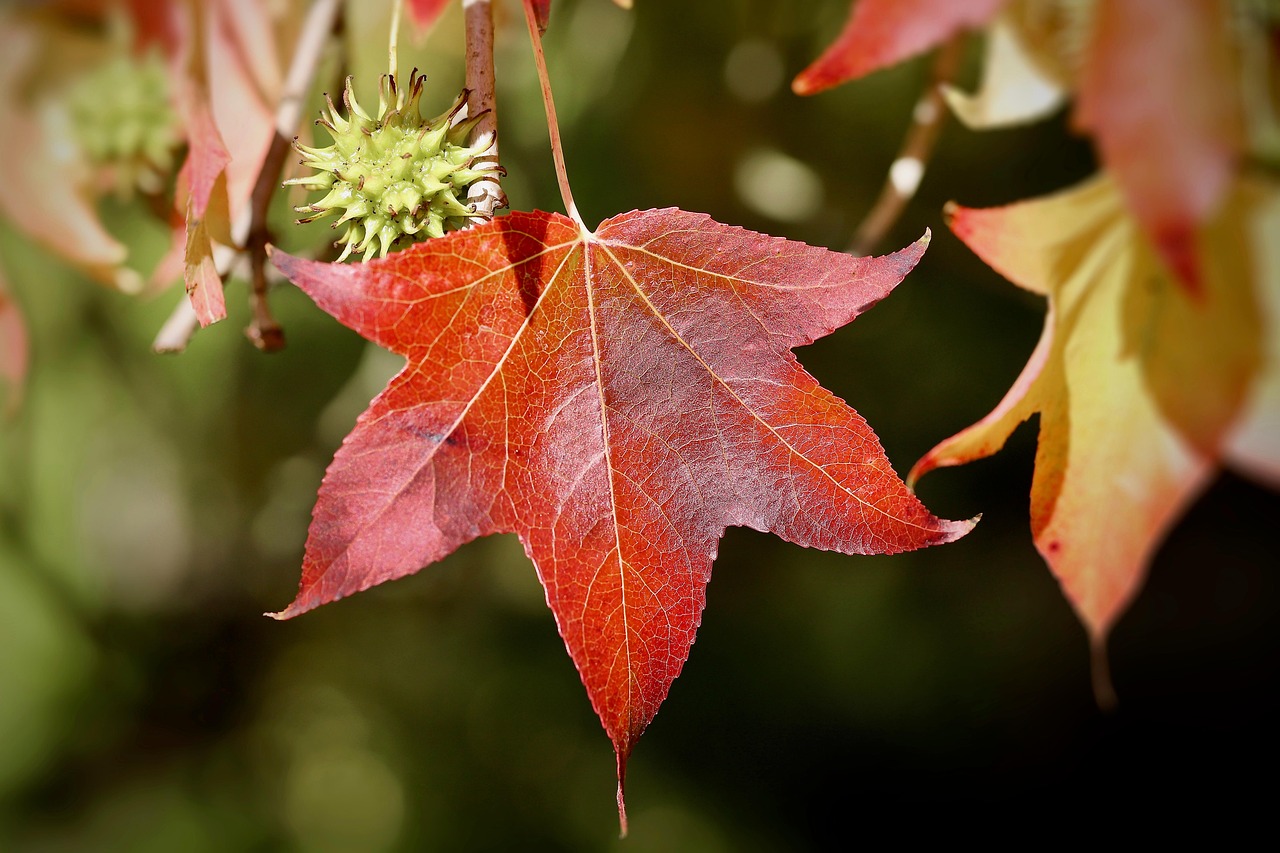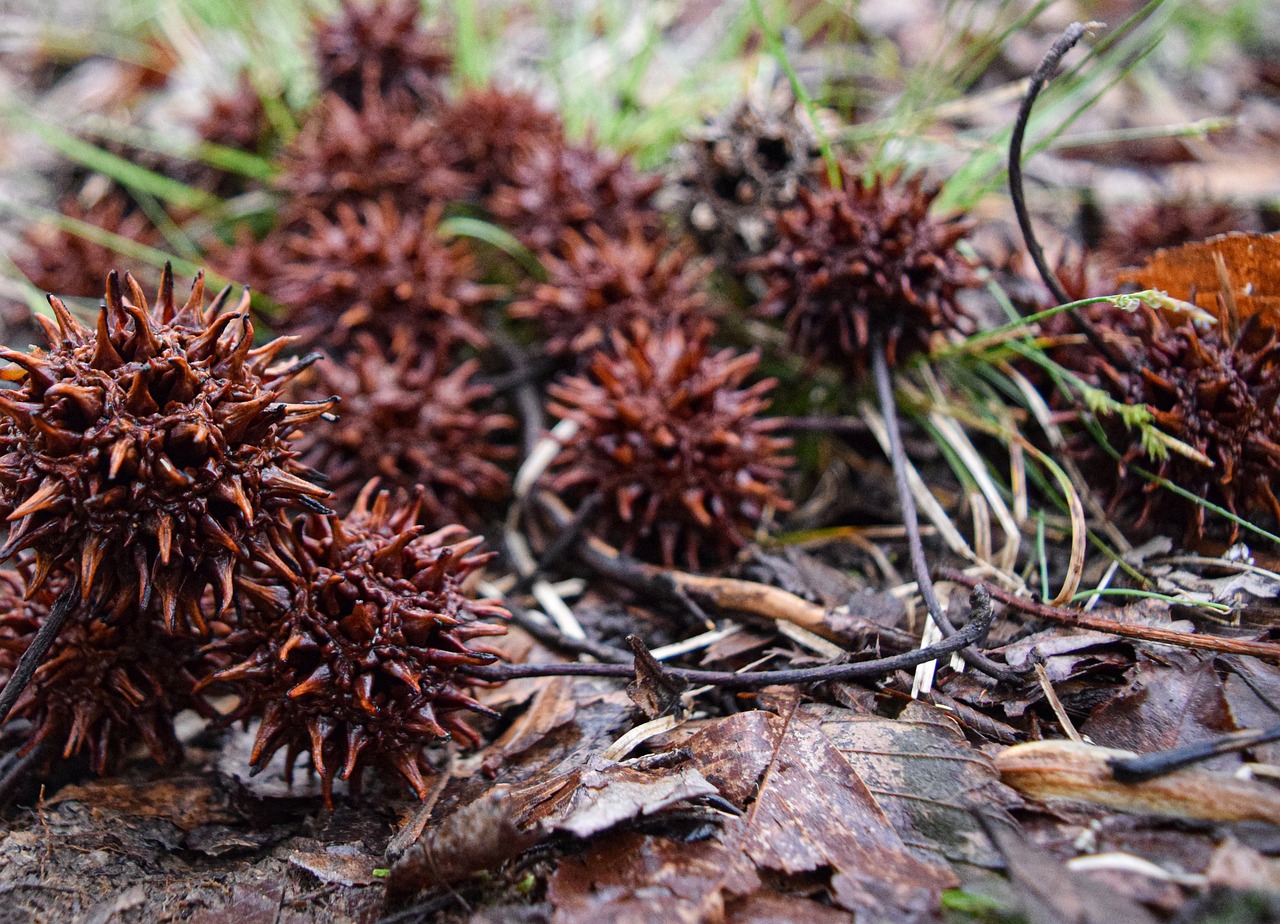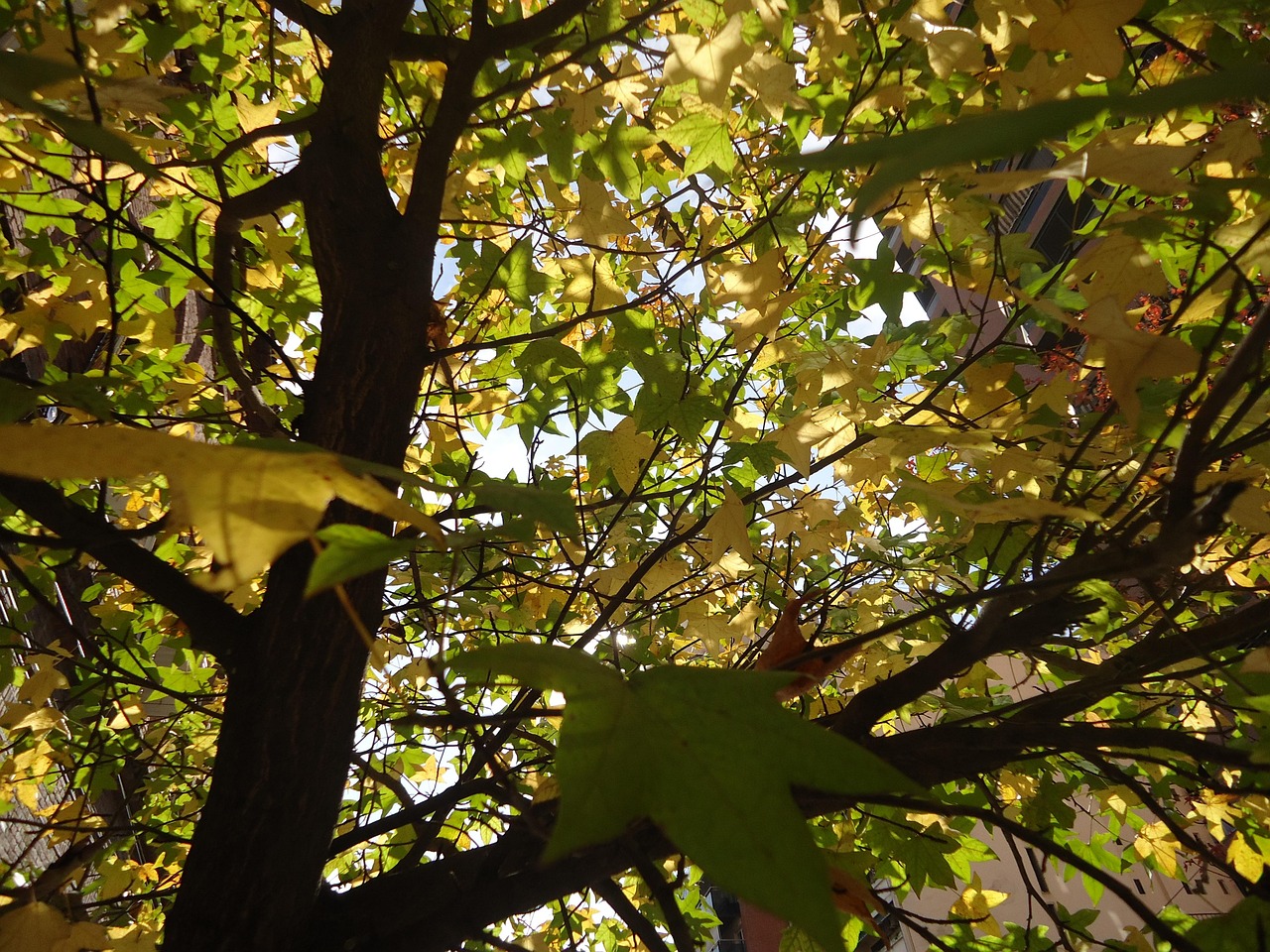Sweetgum trees do not consistently produce gumballs every year. The production of these gumballs is influenced by various factors including weather conditions, tree health, and age. While some trees may produce a significant number of gumballs in certain years, others may have a sparse yield or none at all.
Understanding Sweetgum Trees

Sweetgum trees, scientifically known as Liquidambar styraciflua, are native to the southeastern United States. These deciduous trees are commonly found in various habitats including swamps, lowlands, and upland forests. They are well-known for their distinctive star-shaped leaves and colorful fall foliage, which can range from yellow to deep red and purple.
The sweetgum tree is also famous for its spiky, round seed pods, often referred to as “gumballs.” These gumballs can be a nuisance for homeowners, especially when they fall from the tree and litter the ground. Understanding the lifecycle of sweetgum trees can help in managing their gumball production.
Lifecycle of Sweetgum Trees
Sweetgum trees have a unique lifecycle that affects their gumball production. Here are some stages in their lifecycle that are important to consider:
- Germination: Sweetgum seeds germinate in the spring, typically after a period of cold stratification.
- Seedling Stage: Young sweetgum trees grow rapidly and develop a strong root system.
- Maturity: It takes about 10 to 15 years for sweetgum trees to reach maturity and start producing gumballs.
- Production Cycle: Mature trees produce flowers in spring, which develop into gumballs by late summer.
Factors such as soil quality, water availability, and climate conditions play a crucial role in each stage of growth and can greatly influence gumball production.
Factors Influencing Gumball Production
The quantity of gumballs produced by sweetgum trees can vary significantly from year to year. Several factors contribute to this variability:
- Weather Conditions: Fluctuations in temperature and moisture can affect flowering and seed development. For example, dry spells during the growing season may reduce fruit set.
- Tree Health: Healthy trees are more likely to produce abundant gumballs. Pests and diseases can weaken the tree and reduce its fruit output.
- Age of Tree: Younger sweetgum trees may not produce gumballs consistently. As trees mature, their production typically stabilizes.
- Genetic Variation: Different sweetgum tree varieties may have different capacities for gumball production.
The interaction of these factors can lead to years with bumper crops of gumballs, while other years may yield very few or none at all. This unpredictability is part of what makes sweetgum trees both fascinating and challenging for those who cultivate them.
Environmental Impact of Gumballs
The gumballs themselves play an important role in the ecosystem. They provide food for various wildlife species, including birds and small mammals. However, when they fall, they can create challenges for landscaping and outdoor activities. Homeowners often seek ways to manage fallen gumballs to keep their yards tidy.
Understanding the production cycle and the influencing factors can help anticipate when to expect gumballs from sweetgum trees. This knowledge is beneficial for both tree enthusiasts and homeowners alike.
Managing Gumball Production
For homeowners and landscape enthusiasts, managing the gumball production of sweetgum trees is an important consideration. While these trees can be beautiful additions to any yard, their gumballs can be a nuisance when they fall. There are various strategies that can be employed to manage the impacts of gumball production effectively.
Preventative Measures
Taking proactive steps can help reduce the number of gumballs that fall in your yard. Here are some effective methods:
- Tree Selection: When planting new trees, consider selecting varieties that are known for lower gumball production or even seedless cultivars if available.
- Regular Maintenance: Properly caring for your sweetgum tree can enhance its health and potentially stabilize gumball production. This includes appropriate watering, fertilization, and pruning.
- Location: Plant trees away from high-traffic areas or places where falling gumballs could become problematic, such as driveways or patios.
Seasonal Cleanup Strategies
During the fall and winter months, cleanup efforts become vital. Here are some techniques to manage fallen gumballs:
- Raking: Regularly raking the ground can help keep your yard clean and reduce the accumulation of gumballs. It is best to do this after each significant drop.
- Mulching: Using a mulch layer can help mask the appearance of fallen gumballs and improve the aesthetic of your garden. Mulch can also provide nutrients to the soil.
- Composting: If you have a compost system, consider adding gumballs to it. They can break down over time, contributing organic material to your compost.
Benefits of Gumballs
Despite their potential to create clutter, gumballs also offer benefits that should not be overlooked. Understanding their advantages can help in appreciating sweetgum trees more fully:
- Wildlife Habitat: Gumballs serve as food for various wildlife species. Birds, squirrels, and other small mammals often feed on them, making sweetgum trees valuable for local ecosystems.
- Soil Enrichment: As gumballs decompose, they enrich the soil with organic matter, improving soil structure and promoting healthy growth for other plants.
- Aesthetic Appeal: Even when they fall, gumballs create unique textures and shapes in the landscape, adding to the visual interest of natural settings.
The Role of Climate in Gumball Production
Climate plays a crucial role in determining how many gumballs a sweetgum tree will produce each year. Variations in temperature and precipitation can significantly influence tree health and reproductive success.
Temperature Effects
The temperature during critical growth periods affects flower development and subsequent gumball formation. Here are key points to consider:
- Spring Warmth: Adequate warmth in spring supports flowering, which is essential for gumball production. If temperatures are too low, flowering may be delayed or reduced.
- Frost Risks: Late spring frosts can damage flowers, leading to fewer gumballs. Protecting trees during these periods is crucial for ensuring a good yield.
Precipitation Patterns
The amount of rainfall throughout the growing season also impacts gumball production:
- Water Availability: Consistent moisture is necessary for healthy tree growth. Insufficient rainfall may stress trees, reducing their ability to produce fruit.
- Drought Conditions: Extended dry spells can lead to poor seed development and lower gumball yields. Tree owners should monitor soil moisture levels during dry periods.
Understanding these climatic influences helps tree owners anticipate variations in gumball production from year to year, allowing for better management practices.
Gumball Characteristics and Uses

The gumballs produced by sweetgum trees are not only a notable feature of the tree but also possess unique characteristics and various uses. Understanding these aspects can provide insights into their ecological importance and potential applications.
Physical Characteristics of Gumballs
Sweetgum gumballs have distinct features that set them apart from other tree seeds. Here are some key characteristics:
- Shape and Size: Gumballs are typically round and spiky, measuring about 1 to 2 inches in diameter. Their unique shape gives them a distinctive appearance.
- Color: Initially green, gumballs turn brown as they mature. This color change indicates that they are ready for dispersal.
- Hardness: The gumballs are tough and woody, which helps protect the seeds inside until they are ready to germinate.
Ecological Role of Gumballs
The gumballs serve several ecological functions that contribute to biodiversity. Some of these roles include:
- Seed Dispersal: When animals consume the gumballs, they help in seed dispersal. As they move through the environment, they can drop seeds in new locations, promoting forest growth.
- Habitat for Wildlife: The gumballs provide food for various wildlife species. Birds, squirrels, and other small mammals rely on them as a food source during autumn and winter.
- Soil Enrichment: As gumballs decompose, they enrich the soil with organic material, which benefits other plants and contributes to a healthy ecosystem.
Potential Uses of Gumballs

Beyond their ecological roles, sweetgum gumballs have various uses that can be beneficial to humans as well.
Craft and Decoration
The unique appearance of gumballs makes them appealing for crafts and decorations. Here are some common uses:
- Natural Ornaments: Gumballs can be used in seasonal decorations such as wreaths or centerpieces. Their spiky texture adds an intriguing element to arrangements.
- Educational Projects: Teachers often use gumballs in art projects or science lessons to illustrate concepts related to nature, seeds, and ecosystems.
- DIY Projects: Crafters may use gumballs for various DIY projects, including homemade ornaments or holiday decorations.
Medicinal Uses
In some cultures, components of the sweetgum tree, including its gumballs, have been used for medicinal purposes:
- Traditional Remedies: Some indigenous communities have utilized parts of the sweetgum tree to make remedies for ailments such as coughs or skin irritations.
- Essential Oils: The resin from sweetgum trees can be used to create essential oils that are valued for their aromatic properties and potential health benefits.
Challenges Associated with Gumball Production
While gumballs have numerous advantages, they also come with challenges that homeowners and communities must address. Understanding these challenges is essential for effective management.
Cleanup Efforts
The accumulation of gumballs can lead to significant cleanup efforts, especially in residential areas:
- Littering: When fallen gumballs are not managed, they can create a messy appearance in yards and public spaces. This often leads to increased maintenance work.
- Safety Hazards: The spiky nature of gumballs can pose tripping hazards when scattered across walking paths or driveways.
Pest Attraction
Another challenge posed by gumball production is the attraction of pests:
- Pests and Rodents: The presence of gumballs can attract rodents and other pests looking for food sources. This can lead to issues in gardens and around homes.
- Disease Spread: Accumulated gumballs can contribute to fungal growth or attract pests that may harm the trees themselves.
Addressing these challenges effectively requires a combination of preventive measures, regular maintenance, and community engagement to manage the impacts of sweetgum trees in populated areas.
Future Considerations for Sweetgum Tree Management

As climate change continues to influence weather patterns, it is essential to consider how these changes might affect sweetgum trees and their gumball production. Future management strategies may need to adapt to these evolving conditions to maintain tree health and minimize issues related to gumball production.
Climate Adaptation Strategies
In light of changing climate conditions, several strategies can be employed to ensure the ongoing health of sweetgum trees:
- Monitoring Weather Patterns: Regularly monitoring local climate trends can help homeowners and arborists anticipate periods of drought or excessive rainfall that may affect gumball production.
- Water Management: Implementing effective irrigation practices during dry spells can support tree health and improve gumball yield. This includes using drip irrigation systems to conserve water.
- Diversity in Planting: Incorporating a mix of tree species in landscaping can enhance resilience against pests and diseases, which may be exacerbated by climate change.
Community Engagement and Education
Engaging the community in understanding sweetgum trees and their gumballs can lead to better management practices:
- Workshops: Organizing workshops on tree care, pest management, and the ecological benefits of sweetgum trees can empower community members to take an active role in maintaining their local environment.
- Awareness Campaigns: Raising awareness about the ecological roles of sweetgum gumballs can foster appreciation for these trees, leading to more thoughtful management practices.
- Collaborative Cleanup Initiatives: Encouraging community cleanup events can address litter issues caused by fallen gumballs while promoting community bonding.
Final Thoughts
Sweetgum trees are remarkable species that contribute significantly to their ecosystems. While they do not consistently produce gumballs every year, understanding the factors that influence their yield helps homeowners and tree enthusiasts manage them effectively. Factors such as weather conditions, tree health, and cultural practices play a crucial role in determining gumball production.
The environmental benefits of gumballs, including wildlife support and soil enrichment, highlight their importance beyond mere aesthetics and cleanup concerns. Despite the challenges associated with their production, proactive management strategies can mitigate these issues while capitalizing on the ecological contributions of sweetgum trees.
As climate change continues to affect landscapes worldwide, adapting management practices will be essential for maintaining healthy sweetgum populations. Through community engagement and education, individuals can foster a deeper understanding and appreciation for these trees, ensuring they remain valuable components of our natural environments for generations to come.
